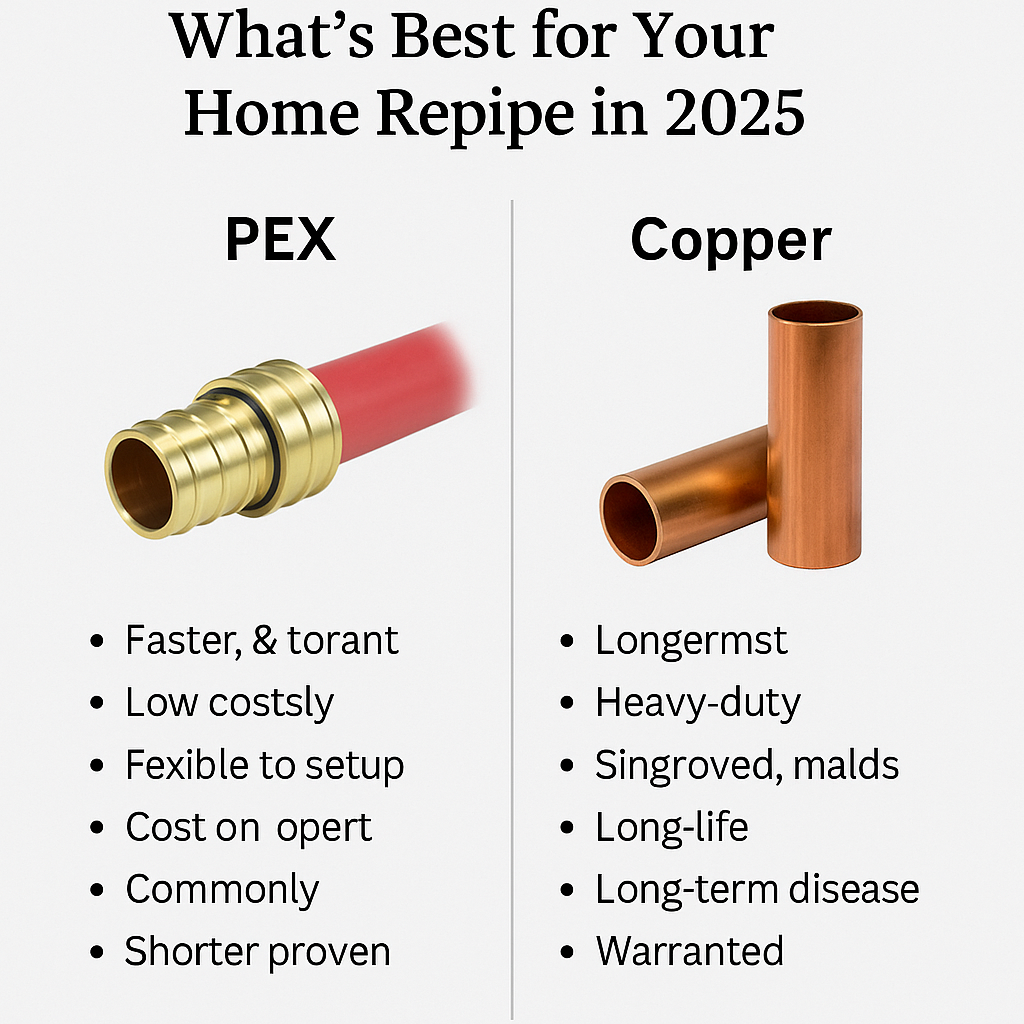- Serving Our NJ Neighbors 24/7 (888) 333-2422
Understanding PEX and Copper Piping: Pros, Cons, and Key Differences

When it comes to repiping your home in 2025, the two dominant choices remain PEX (cross-linked polyethylene) and copper. Each has its own set of strengths, weaknesses, and ideal use cases. Copper has been the gold standard in plumbing for decades, known for its durability, fire resistance, and long lifespan—often exceeding 50 years. It’s a tried-and-true material that adds value to your home and resists bacteria growth. However, copper prices fluctuate with the global metals market, and installation is labor-intensive, requiring open flame or soldering for connections.
On the other hand, PEX piping has seen massive adoption in recent years due to its flexibility, cost-effectiveness, and ease of installation. PEX can bend around corners, reducing the need for fittings, and is more resistant to freezing temperatures compared to copper. It also requires less labor and doesn’t corrode like metal. However, PEX isn’t without downsides—UV sensitivity, potential chemical leaching (depending on water type and PEX brand), and shorter proven lifespan can raise concerns for some homeowners. But as of 2025, many of these issues have been mitigated by advancements in PEX manufacturing, including new UV-stable and chlorine-resistant variants.
Ultimately, the choice between PEX and copper depends on factors like budget, local building codes, water quality, long-term plans for the home, and even personal preference. Both materials are widely approved and used across the U.S., but understanding their core differences is key to making an informed repiping decision.
Cost Comparison in 2025: Installation, Materials, and Long-Term Value
Cost is one of the biggest deciding factors when choosing between PEX and copper piping in 2025. Copper piping installations can cost between $8,000 and $15,000 for a standard 2-bathroom home, depending on pipe length, wall access, and labor rates in your area. PEX repiping, by contrast, is often 30%–50% cheaper, ranging from $4,000 to $10,000 for the same home. The reduced labor and quicker installation process make PEX the more budget-friendly choice for most homeowners.
Another major cost factor is material pricing. Copper is a commodity and subject to market volatility, which means prices can rise without warning. In contrast, PEX is made from plastic polymers and generally sees more stable pricing trends. Moreover, because PEX can be snaked through walls and tight spaces, it minimizes the need for extensive drywall cuts and repairs, further reducing installation costs. For new construction or full renovations, both options are feasible, but for retrofit jobs, PEX offers significant cost and time advantages.
However, long-term value isn’t just about installation cost. Copper may have a longer historical track record, and some buyers may perceive it as higher quality, which could slightly enhance resale value. PEX systems, especially those installed using high-grade expansion fittings and manifold systems, also offer excellent performance and reliability when installed by professionals. Most PEX systems today come with warranties between 25–30 years, giving homeowners peace of mind. In short, while copper still holds a place in high-end custom homes, PEX is often the better long-term investment for standard residential repiping projects in 2025.
Making the Right Choice: Local Codes, Home Age, and Water Quality Factors
Choosing between PEX and copper isn’t just about price and convenience—your local building codes, home’s age, and water quality also play a big role. For example, some municipalities still have restrictions on certain types of PEX, particularly older versions. Always check whether your town or city approves PEX for potable water systems and requires specific types of fittings or installation techniques. Licensed plumbers familiar with local codes can help guide this decision and ensure everything is up to standard.
For older homes, repiping can be more complex. If your home was built before 1970 and still has galvanized steel or early-generation copper pipes, it might be time for a full upgrade. In these scenarios, PEX offers a more flexible and less invasive solution, especially if walls and ceilings are finished. On the flip side, in homes with open framing or during remodels, copper installation becomes more feasible. Also, if your area has acidic or high-mineral water, copper may corrode over time, making PEX a more resistant alternative.
In 2025, water safety and filtration are top homeowner priorities. Both PEX and copper have passed NSF/ANSI safety standards, but PEX is increasingly being used in homes with advanced water filtration systems. If you’re already filtering your water or planning to install a whole-house filter, PEX may be the ideal companion. That said, if you’re in an area with high chlorine content or soft water, make sure you use chlorine-resistant PEX-A or PEX-B models.
Ultimately, the decision comes down to your unique situation—budget, timeline, water conditions, resale goals, and project scope. Consulting a licensed, local plumber who understands both PEX and copper piping systems will help ensure your repipe investment is smart, code-compliant, and built to last.





